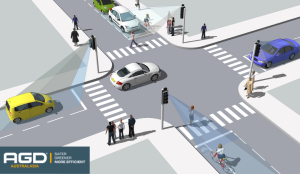
What is Stop-Line Detection — And Why It’s Critical for Smart Junctions?
In our global commitment toward a smarter, more efficient and green-conscious transport future, one question faced by our city and traffic management planners : Are we making the most of our signalised intersections or can we make it even more efficient?
One of the most critical pawn of this chess, often overlooked element in that answer is Stop-Line Detection – a foundational component in the evolving landscape of adaptive signal control and intelligent transport systems (ITS).
Stop-line detection refers to the ability to accurately identify vehicles (or sometimes pedestrians, cyclists or specific type of vehicle) that has reached the stop line at an intersection – just before or during a red signal phase.
Accuracy and speed of availability of this data enables traffic signal controllers to make real-time decisions based on presence or absence of vehicles at the line. When tied into smart control systems like SCATS, stop-line detection plays a vital role in managing signal timings dynamically, improving flow and reducing idle times. That means less congested roads, cleaner air to breathe and more people can opt for options like walking or bikes.
Why Is Stop-Line Detection So Important?
Stop-line detection isn’t just a nice-to-have — it’s a bedrock of modern intersection efficiency. Here’s why:
- Accurate Signal Responsiveness and reduced lost hours for drivers
Knowing whether a vehicle is waiting at the line allows the signal to either extend the green phase or switch more efficiently — minimising unnecessary wait times and more adaptability to peak hour demands. This also means that people are less time on road commuting and more time where they need to be.
- Public Transport Priority
Detection systems (like the AGD650) can differentiate vehicle classes (buses, trucks, EVs), enabling priority control to favour public or emergency vehicles while maintaining safety for pedestrians and cyclists.
- Reduces Wasted Green Time
No more unnecessary green light phases for non-existent traffic and empty lanes. Stop-line data ensures optimal timing based on real presence which when planned properly can also reduce impact on the nodes that generally bottle necks for traffic jams.
- Safety for All Road Users
Detecting vehicles, bikes, or pedestrians at the line improves safety by preventing skipped phases or missed crossings — especially important in multimodal or high-pedestrian intersections.
- Reduced environmental impact
Less idling time also means less fuel wasted and lesser pollution. If AGD radars are used then end of life recycling means no environmental or landfill impact as well.
How Is Stop-Line Detection is programmed?
Traditionally, this has been handled by inductive loop systems — wires embedded into the road surface that trigger when a vehicle passes over them.
But as cities move toward more busier times, lower-maintenance solutions, above-ground radar detectors like the AGD’s range are becoming the gold standard globally.
Radar-Based Stop-Line Detection:
- Installed on poles (no trenching or road closures)
- Uses AI-powered radar with deep learning for real-time accuracy
- Easily configured via Wi-Fi (AGD Touch) from the roadside
- Detects stationary and moving vehicles
- Distinguishes between vehicle types for intelligent filtering
Stop-line not only plays a crucial role in modern era’s traffic management. But if implemented thoughtfully, they will make us future ready for new fleet of transportation as well as the impact of increased road users as the population grows.


